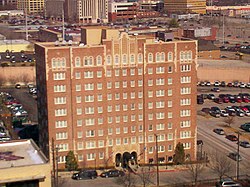
The Ingalls Building, built in 1903 in Cincinnati, Ohio, is the world's first reinforced concrete skyscraper. The 16-story building was designed by the Cincinnati architectural firm Elzner & Anderson and was named for its primary financial investor, Melville E. Ingalls. The building was considered a daring engineering feat at the time, but its success contributed to the acceptance of concrete construction in high-rise buildings in the United States. It was converted to a hotel, the Courtyard by Marriott Cincinnati Downtown, in 2021.

Nashville's Union Station is a former railroad terminal designed by Richard Montfort, chief engineer of the Louisville and Nashville Railroad (L&N), and built between 1898 and 1900 to serve the passengers of the eight railroads that provided passenger service to Nashville, Tennessee, at the time, but principally the L&N. Built just west of the downtown area, it was spanned by a viaduct adjacent to the station and positioned to the east and above a natural railroad cut, through which most of the tracks in the area were routed. The station was also used by streetcars prior to their discontinuance in Nashville in 1941.

The Aloft Liverpool Hotel, formerly the Royal Insurance Building, is a historic building located at 1-9 North John Street, Liverpool, Merseyside, England. It was built as the head office of the Royal Insurance company.

The Blackstone Hotel is a historic 290-foot (88 m) 21-story hotel on the corner of Michigan Avenue and Balbo Drive in the Michigan Boulevard Historic District in the Loop community area of Chicago, Illinois. Built between 1908 and 1910, it is on the National Register of Historic Places. The Blackstone is famous for hosting celebrity guests, including numerous U.S. presidents, for which it was known as the "Hotel of Presidents" for much of the 20th century, and for contributing the term "smoke-filled room" to political parlance.
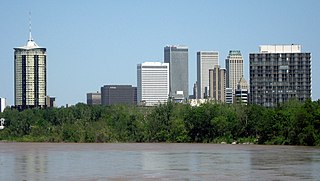
Tulsa is the second-largest city in the state of Oklahoma. It has many diverse neighborhoods due to its size.

The Vinoy Hotel is an historic Mediterranean Revival-style hotel opened in 1925 as the Vinoy Park Hotel. It is located in St. Petersburg, Florida at 501 Fifth Avenue Northeast, on the bayfront area of downtown, overlooking the Vinoy Yacht Basin. The hotel is a member of Historic Hotels of America, the official program of the National Trust for Historic Preservation.
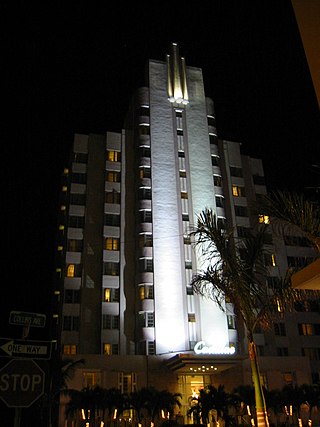
The Cadillac Hotel & Beach Club is a historic U.S. hotel in Miami Beach, Florida. It is located at 3925 Collins Avenue. On October 5, 2005, it was added to the U.S. National Register of Historic Places (NRHP).

The Blackstone Hotel is the tallest hotel in downtown Fort Worth, Texas, at 268 ft (82 m) tall. Located on the corner of Fifth and Main Streets, it is noted for its Art Deco design with terracotta ornamentation and setbacks on the top floors. The hotel was constructed in 1929 and operated for over 50 years before it sat vacant for nearly 20 years. The Blackstone Hotel guest list is full of notable people including Presidents of the United States: Harry S. Truman, Dwight D. Eisenhower, John F. Kennedy, Lyndon B. Johnson, and Richard M. Nixon. The hotel was also host for a few movie stars such as Bob Hope, Clark Gable, and Elvis Presley. It was added to the National Register of Historic Places on February 2, 1984. The building was restored in the late 1990s and is still in use today as the Courtyard Fort Worth Downtown/Blackstone, although it is still known as the "Blackstone Hotel" to those who live in or have ties to Fort Worth.

Colcord Hotel is a luxury boutique hotel located in downtown Oklahoma City, in the U.S. state of Oklahoma. The building was finished in 1909 and has been considered Oklahoma City's first skyscraper. It is 145 feet (44 m) tall and has 14 floors.

The Hotel Blackhawk is an eleven-story brick and terra cotta building located in Downtown Davenport, Iowa, United States. It is a Marriott Autograph Collection property.
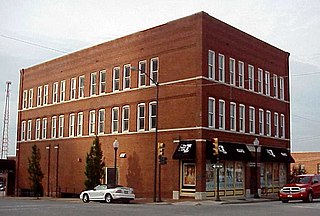
The Pierce Block is a historic building in downtown Tulsa, Oklahoma on the northeast corner of Third Street and Detroit Avenue, that was constructed as a hotel in 1909. According to the Tulsa Preservation Commission, it is the oldest remaining post-statehood hotel in Tulsa. Originally it was a few blocks west of the Midland Valley Railroad passenger station, which was at Third and Greenwood Avenue.
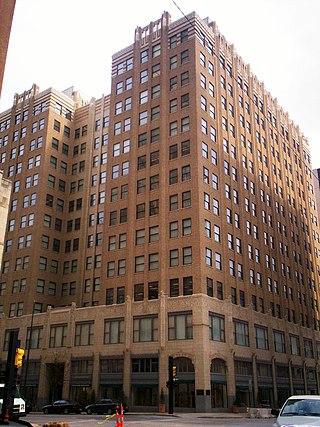
The Philcade Building is an office building in downtown Tulsa, Oklahoma at the southeast corner of East 5th Street and South Boston Avenue. Designed by Leon B. Senter, for oilman Waite Phillips, it was begun in 1929 and completed in 1931. It is noted for its Art Deco zigzag style architecture. The building was listed in the National Register on September 18, 1986, under National Register Criterion C. Its NRIS number is 86002196. It is also a contributing property of the Oil Capital Historic District in Tulsa.

The Oil Capital Historic District (OCHD) is an area in downtown Tulsa, Oklahoma that commemorates the success of the oil business in Tulsa during the early 20th century. During this period, Tulsa was widely known as "The Oil Capital of the World." The area is bounded by 3rd Street on the north and 7th Street on the south, Cincinnati Avenue on the east and Cheyenne Avenue on the west.

The Mincks-Adams Hotel is located one block west of the Oil Capital Historic District, at 403 Cheyenne Avenue in Downtown Tulsa, Oklahoma. It was constructed in 1927–1928 by businessman I. S. "Ike" Mincks and named the Mincks Hotel. It was a luxury hotel intended to attract businessmen, and was opened for guests in time for the first International Petroleum Exposition. Mincks declared bankruptcy in 1935. The hotel was sold at a liquidation sale and subsequently reopened under new ownership as the Adams Hotel. It was converted to the Adams Office Tower in the early 1980s. The building is noted for its architecture and was listed on the National Register of Historic Places (NRHP) under Criterion C on November 7, 1977, with NRIS number 78002273.
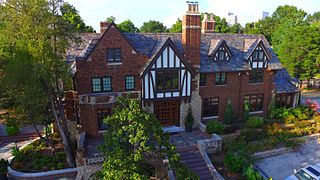
The McBirney Mansion in Tulsa, Oklahoma was the home of James H. McBirney, co-founder of the Bank of Commerce in Tulsa in 1904. He was the original owner of the mansion, built by architect John Long in 1928, and lived there until 1976. The mansion contained 15,900 square feet (1,480 m2) and sits on a 2.91 acres (11,800 m2) lot. The mansion was bought by Donna and Roger Hardesty who lived there for 5 years. Eventually it was bought by a law firm that turned it into a law office. By 2007, was purchased by former American Airlines President George Warde, who had plans to transform it into a boutique hotel. In the meantime, the McBirney Mansion was used as an event center. Warde died in 2012, and events stopped being held at McBirney. By February 2012, the Pauls Corporation, a Denver real estate management company, acquired the mansion as part of the suit's settlement. Tulsa attorney, Gentner Drummond, bought the mansion from Pauls Corp. in 2014, announcing his intention to make it his family's home.
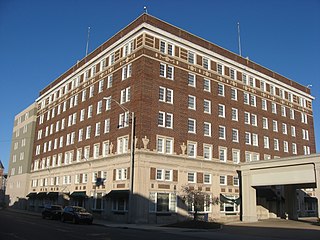
Roberts Hotel is a historic hotel located at Muncie, Delaware County, Indiana. It was built in 1921, and is a six-story, Colonial Revival style steel frame building sheathed in red brick with limestone detailing. The basement, first, and mezzanine floors measure 120 feet by 125 feet, where the second through sixth floors above are "L"-shaped. It has a flat roof behind a parapet. The hotel closed in 1972, but reopened in 1976. The building has been renovated into loft apartments.

The Davenport Hotel Collection is a brand collection of four upscale hotels in Spokane, Washington. All the hotels are located in Downtown Spokane. The brand is owned by KSL Capital Partners and operated by the Davidson Hospitality Group.

The Gillette-Tyrrell Building is a building in downtown Tulsa, Oklahoma. It was begun in 1929 by two Tulsa oilmen, J. M. Gillette and H. C. Tyrrell. They initially planned to construct a three-story office building at 432 S. Boulder Avenue, topped by a ten-story hotel, but these plans were canceled during the Great Depression and they stopped construction at the third floor. In 1931, they sold it to the Knights of Pythias, who decided to complete it as an office building and renamed it the Pythian Building.
The Tulsa Club Building is an 11-story structure that stands on the northwest corner of Cincinnati Avenue and East Fifth Street, inside the Oil Capital Historic District of Tulsa, Oklahoma, United States. Designed by Bruce Goff and constructed in 1927 by the architectural firm Rush, Endacott and Rush, it was a joint venture of the Tulsa Club and the Tulsa Chamber of Commerce.

The Glenn Building is a historic building on Marietta Street in downtown Atlanta, Georgia, United States. Built in 1923 as an office building, the building was converted to a boutique hotel in 2006 and added to the National Register of Historic Places in 2008.
